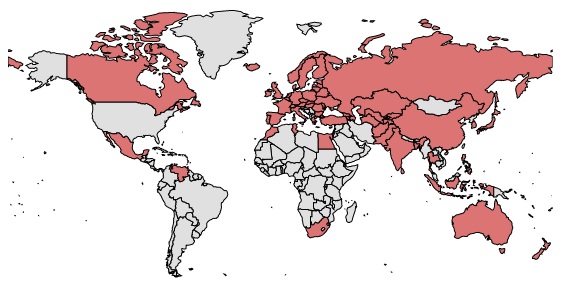The Branch Profits Tax
The branch profits tax is imposed on foreign corporations engaged in a U.S. trade or business through a branch, rather than a subsidiary. The branch profits tax is imposed in addition to any tax on income that is effectively connected1 to the conduct of the business.
In other words, under the branch profits tax, foreign corporations with U.S. branches are, in theory at least, subject to two levels of tax: (i) At the entity level when the U.S. branch earns income, and (ii) at the shareholder level when the earnings are deemed to be repatriated.
In effect, the branch profits tax treats the U.S. branch of a foreign corporation as if it were a subsidiary-at least for purposes of taxing the repatriation of profits. This puts the earnings and profits of a foreign corporation's branch that are deemed to be repatriated to its home office on equal footing with the earnings and profits of a U.S. subsidiary that are paid out as a dividend to its foreign parent. By treating a branch's profits as though they were remitted to the foreign corporation, the branch profits tax effectively eliminates the advantage of operating as a U.S. branch rather than a subsidiary with respect to the repatriation of profits.
The Taxation of a Foreign Corporation's Effectively Connected Income, Generally
Foreign corporations that have a trade or business in the U.S. may be subject to tax on the income that is effectively connected with that U.S. trade or business at normal corporate tax rates. A foreign corporation has effectively connected income if it is engaged in a trade or business within the U.S. and has income connected to that trade or business. For example, a foreign corporation that performs services in the U.S. is engaged in a trade or business in the U.S. and has effectively connected income.
The Branch Profits Tax, Generally
The branch profits tax was enacted under the Tax Reform Act of 1986. It was intended to put a U.S. branch of a foreign corporation on par with a U.S. subsidiary of a foreign corporation.
The branch profits tax imposes a 30% tax (or lower rate under an applicable treaty) on the after-tax earnings of a foreign corporation's U.S. trade or business that are not deemed to be reinvested in that U.S. trade or business. The branch profits tax is imposed on the "dividend equivalent amount." As such, the branch profits tax treats a U.S. branch of a foreign corporation as if it were a subsidiary of a foreign corporation.
The branch profits tax is imposed in addition to the tax imposed by section 882 on effectively connected income.
Note that the termination or incorporation of a U.S. trade or business, or the liquidation or reorganization of a foreign corporation or its domestic subsidiary, may impact the branch profits tax.
The Dividend Equivalent Amount
The term "dividend equivalent amount" is defined as a foreign corporation's effectively connected earnings and profits, with certain adjustments. The dividend equivalent amount is similar to dividends paid by a subsidiary either out of current E&P not yet invested or out of accumulated E&P invested in subsidiary assets.
To determine the dividend equivalent amount, we start with the effectively connected earnings and profits. Effectively connected earnings and profits are the earnings and profits (or deficits) determined under section 312 and Treasury Regulations that are attributable to effectively connected income (within the meaning of the Treasury Regulations).2 Because the phrase effectively connected income includes income treated as effectively connected, income that is effectively connected income under section 842(b) (minimum net investment income of an insurance business) or 864(c)(7) (gain from property formerly held for use in a U.S. trade or business) gives rise to effectively connected earnings and profits. Effectively connected earnings and profits also includes earnings and profits attributable to effectively connected income of a foreign corporation earned through a partnership, and through a trust or estate. For purposes of section 884, gain on the sale of a U.S. real property interest by a foreign corporation that has made an election to be treated as a domestic corporation under section 897(i) will also give rise to effectively connected earnings and profits.
Generally, the effectively connected earnings and profits are adjusted (up or down) to reflect increases or decreases in the branch's investment in United States assets (i.e., its U.S. net equity). The dividend equivalent amount is reduced by the increase in a U.S. branch's U.S. net equity. It is increased by a U.S. branch's decrease in U.S. net equity.
U.S. net equity equals U.S. assets minus U.S. liabilities. The Treasury Regulations provide elaborate rules for the calculation of U.S. net equity.
There are two ways to increase U.S. net equity: use the profits to purchase additional U.S. assets or to reduce U.S. liabilities. Branch income that is reinvested in qualifying branch (U.S.) assets is not considered repatriated to the foreign home office.
On the other hand, if branch income is not reinvested in qualifying U.S. assets, then it is deemed repatriated.
Tax Treaties
The United States is a signatory to more than 60 income tax treaties. With some exceptions, a qualifying foreign corporation that is a resident of a country with which the United States has an income tax treaty and that has a dividend equivalent amount.
Our Freeman Law interactive tax treaty map provides a link to tax treaty materials for each U.S. treaty partner:
If the foreign corporation satisfies the limitation on benefits provisions of the applicable tax treaty with respect to the dividend equivalent amount, the foreign corporation will not be subject to the branch profits tax on that amount (or will qualify for a reduction in the amount of tax with respect to such amount) if-
(i) The foreign corporation is a qualified resident of such country for the taxable year;3 or
(ii) The limitation on benefits provision, or an amendment to that provision, entered into force after December 31, 1986.
A foreign corporation that, in any taxable year, is a qualified resident of a country with which the United States has an income tax treaty in effect solely because it meets the requirements of § 1.884-5(b) and (c) (relating, respectively, to stock ownership and base erosion) is exempt from the branch profits tax or subject to a reduced rate of branch profits tax pursuant to a treaty with respect to the portion of its dividend equivalent amount for the taxable year attributable to accumulated effectively connected earnings and profits only if the foreign corporation is a qualified resident of the treaty country under the Treasury Regulations, in whole or in part, in a consecutive 36-month period that includes the taxable year of the dividend equivalent amount. A foreign corporation that fails the 36-month test is exempt from the branch profits tax or subject to the branch profits tax at a reduced rate with respect to accumulated effectively connected earnings and profits (determined on a last-in-first-out basis) accumulated only during prior years in which the foreign corporation was a qualified resident of such country.
Foreign corporations should also analyze whether they have Form 5472 or other reporting obligations.
Footnotes
1 For purposes of the branch profits tax, under applicable regulations the term "effectively connected income" means income that is effectively connected with the conduct of a trade or business in the United States and income that is treated as effectively connected with the conduct of a trade or business in the United States under any provision of the Code. The term effectively connected income also includes all income that is or is treated as effectively connected with the conduct of a U.S. trade or business whether or not the income is included in gross income (for example, interest income earned with respect to tax-exempt bonds).
2 The term "ECEP" does not include any earnings and profits attributable to-
(i) Income excluded from gross income under section 883(a)(1) or 883(a)(2) (relating to certain income derived from the operation of ships or aircraft);
(ii) Income that is ECI by reason of section 921(d) or 926(b) (relating to certain income of a FSC and certain dividends paid by a FSC to a foreign corporation or nonresident alien) that is not otherwise ECI;
(iii) Gain on the disposition of a U.S. real property interest described in section 897(c)(1)(A)(ii) (relating to certain interests in a domestic corporation);
(iv) Income that is ECI by reason of section 953(c)(3)(C) (relating to certain income of a captive insurance company that a corporation elects to treat as ECI) that is not otherwise ECI;
(v) Income that is exempt from tax under section 892 (relating to certain income of foreign governments); and
(vi) Income that is ECI by reason of section 882(e) (relating to certain interest income of banks organized under the laws of a possession of the United States) that is not otherwise ECI.
3 Note that if a foreign corporation is a qualified resident only with respect to one of its trades or businesses in the United States, i.e., the trade or business that is an integral part of its business conducted in its country of residence, and not with respect to another, the treaty exceptions may only apply to that portion of its dividend equivalent amount attributable to the trade or business for which the foreign corporation is a qualified resident.
The content of this article is intended to provide a general guide to the subject matter. Specialist advice should be sought about your specific circumstances.


